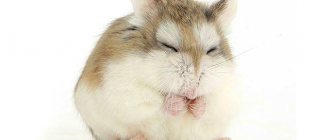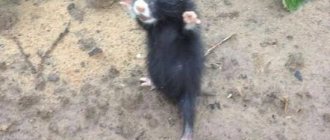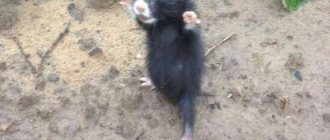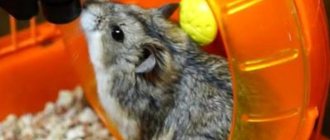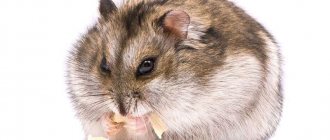The steppe hamster (common) is a large self-spreading rodent species that has virtually nothing in common with domestic pets. It is distinguished by small ears, well-developed toes, and is excellent at digging holes and doing other things. But the most important thing is that he is able to live independently; he not only does not need human help, the hamster will aggressively accept it. Sometimes it is much safer to meet a snake or a poisonous spider than this wild and vicious rodent.
Description of the species
You can see quite a lot of features at one glance at such a rodent as the steppe hamster. The description of its appearance is as follows:
- stocky body with a thick head and short neck;
- small ears, shiny and relatively huge eyes;
- short paws with well-developed toes and short claws.
The fur of this animal includes two elements: the base and the undercoat. Thanks to the latter, the hamster can easily endure winters and sub-zero temperatures. The color is usually light yellow or brown. Dark and black spots are common.
A characteristic feature is that hamsters have white feet. But the front and hind limbs are black on the inside.
But this does not mean that you will not be able to meet a steppe hamster, which will have a completely different color. Sometimes you can see completely white or, on the contrary, completely black representatives of the family.
Separately, it is necessary to say about the sizes. Males reach a length of 34 cm excluding the tail. The latter can reach up to 5 cm in length.
Keeping gophers at home: where to house them and what to feed them?
The gopher is not a very suitable animal for keeping in captivity for several reasons:
- It is nocturnal, so you won’t be able to see it very often.
- This is a wild animal that is reluctant to make contact with humans; it is uncommunicative and prefers to hide in its hole or house. If the decision to get a gopher has already been made, then it is best to get the most captivated and friendly thin-toed representative of the species.
- You will have to clean his cage often; the urine of this animal has a specific bright smell that sharply “hits the nose”, especially for a person who is not used to it.
- In warm home conditions it does not reproduce and most likely will not survive until spring, since nature dictates that it is in a state of suspended animation in a cold environment during the winter.
- The cage for one animal should be 0.5 by 1 meter in size and increased by 1.5 times for each new resident. The cage must be strong enough so that it cannot be chewed through. It is also necessary to provide the animal with hay and straw to insulate the house, wooden sticks from willow, hazel, apple trees and other crops for grinding down constantly growing teeth, to come up with various tunnels, labyrinths and boxes so that the gopher can lead an active lifestyle, as in the wild. It is best to keep the animal outside in a specially designated area or in an enclosure; before placing the rodent, the floor must be concreted. When raising an animal in an aquarium, it is necessary to provide a metal lattice on top, tightly attached to the walls; by jumping, the animal can grab onto the aquarium and crawl out.
- Be careful when you wash the cage or feed your pet; you can use additional devices during cleaning, for example, a tall jar that will be difficult to get out of, or a special ball for hamsters. Do not leave the animal unattended!
- Drinking water must be clean!
Distribution area
The steppe hamster is distributed over quite wide areas. It lives in lands from Europe to China. In particular, in Russia it can be found in the open spaces from Smolensk to the southern taiga.
This hamster does not require any special living conditions, which is why it can live virtually anywhere. For the most part, animals are found near grain and wheat fields. Some individuals dig their burrows directly on these arable lands. The rest prefer to live closer to people. They settle near villages and hamlets. The food consists of various products from the garden.
It is not uncommon for hamsters to visit barns and storerooms. Like house mice, they carry supplies into their burrows. But, unlike them, hamsters are much more dangerous, as they are aggressive against humans. Therefore, it is necessary to set traps if such a “neighborhood” is suddenly noticed.
Lifestyle
Hamsters are nocturnal animals, and therefore their activity time is late at night, sometimes early in the morning.
During the day, these animals sit in burrows and will leave their shelter only in case of imminent danger. They lead a solitary lifestyle and, despite their small size, zealously defend their territory from the encroachments of other rodents. Males are friendly to females only during the mating period. The rest of the time they do not show attention, but they can also be aggressive when it comes to survival or the fight for food.
Information in the encyclopedia talks about the increased aggressiveness of animals. They can attack a person for no reason simply from a hole. Such situations especially occur in the fall, when the animal is preparing supplies for the winter. Hamsters' teeth are small and very sharp, and therefore the bites leave deep, with severe pain. The wound may be infectious, so urgent disinfection or hospitalization is required.
Steppe hamsters often attack other animals. The size, weight and appearance of the enemy are not important; the speed and sharp teeth of this rodent can put even a fox or wolf to flight.
Hamster hole
The steppe hamster spends most of its life in a burrow. This is not at all due to the fact that he is afraid to leave the confines of his home. The animal is quite fearless. But to hunt, he needs a lot of rest.
The hamster hole goes 1-2 meters deep into the earth. It all depends on how easy it is to dig the soil. The basis of the house consists of:
- living chamber;
- inclined exit;
- steep entrance.
The living chamber, in turn, has three “doors”. The first two are intended to ensure that the animal can freely enter home and leave if necessary. And the third door is oriented to the room with supplies. Only in winter and early spring does the hamster use products from there; on other days its diet consists of fresh grains, vegetables and fruits.
How to identify a hamster? You can do this based on characteristic buildings. They are easily recognized by small piles of earth located directly near the inlet/outlet. They are sprinkled with grain husks on top.
Using a small stick, you can find out whether a rodent lives in the found hole. It needs to be placed inside and then pulled out. If cobwebs, moss, husks or grass are found on it, then the dwelling is abandoned. No hamster would keep his house in disarray.
Interesting answers
- Nettle - message report (grades 2, 3, 4) Nettle is known to be beneficial and irritate the skin when touched. Nettle is a perennial green plant that grows up to 1.2 m in height, and the bush grows up to 1 m in width. It grows like a weed and is not picky about climate and care.
- Mica is a mineral (report message 2, 3, 4 class the world around us. Geography) Mica is one of the most common minerals. But despite this, the upper layers of the earth’s crust contain no more than 4 percent.
- The story of Fedya in the story of Bezhin Lug Turgenev This is how he showed his upbringing (He believed that this is how children from rich families should behave)
- The life and work of Evgeny Schwartz Evgeny Lvovich Schwartz (1896-1958) is an outstanding Soviet playwright, prose writer, and screenwriter, whose creative work includes more than twenty-five plays.
- The Life and Work of Carlo Gozzi Carlo Gozzi (1720-1806) is a famous Italian playwright and writer, from whose pen a large number of fairy-tale plays, called fiabs, based on folklore elements of the storyline came out
Feeding the steppe hamster
What does a hamster eat? It is impossible to specify this moment in any way. Everything directly depends on the place where he lives. If its habitat is focused on places near grain fields, then it will feed mostly on grain crops. At the same time, its harm to agriculture will be minimal. Moreover, often during their trips for supplies, hamsters eat small insects and animals, which makes it easier for humans to get rid of them.
If the animal has settled near a village, then the basis of its diet will be vegetables and those crops that are most popular in the region. But they cannot be collected as supplies for the winter, so hamsters have to destroy people's warehouses and barns to find grains.
It is not uncommon for hungry animals to attack chickens, especially if there is no chicken nearby to protect them or at least make some noise.
Ultrasonic repellers
Recently, various devices for controlling rodents in the country have become increasingly popular. Ultrasonic repellers are widely used for these purposes, which emit sounds that are intolerable to the pest but inaudible to humans.
The following advantages of this method can be highlighted:
- there are no corpses left on the site, the animals simply run away;
- there is no chance of poisoning;
- ultrasound will help drive out not only karbysh, but also field mice, moles and rats;
- you can turn on the device only at night, because your enemies lead a twilight lifestyle and rarely make forays during the day;
- The method of combating is absolutely not labor-intensive, you just need to insert batteries and install the devices in your summer cottage.
However, the ultrasonic method is not the most reliable due to obvious disadvantages:
- Karbysh do not die, but simply leave your site. Your neighbors won't thank you for such an expulsion.
- When the batteries in the device run out, the animals will return again (not relevant for ultrasonic devices operating on mains power).
- The device is quite expensive, plus high costs for batteries or electricity consumption.
- Pets can also perceive ultrasound, but it is harmful to them.
There is also an opinion in scientific circles that ultrasound is harmful to humans, although their hearing is not susceptible to high-frequency sound waves. Ultrasound radiation can destroy the membrane structures of cells, causing various diseases. That is, this method is best used when there are neither pets nor the owners themselves at the country estate.
There are ultrasonic repellers that operate on batteries, but they are not easy to find in stores. Much more common are devices that connect to the mains. Below are the models that are most in demand in the fight against wild hamsters.
- "Tornado". Powered by mains, coverage area – 4 acres. Costs from 2100 rubles. A more powerful device with a coverage of 8 acres can be purchased for 3,200 rubles.
- "Typhoon 800". Also works from a wall outlet. Effective on a garden plot with an area of 8 acres. Cost – from 1400 rubles.
- "Grad 500". Powered by AA batteries, coverage area up to 5 acres. Minimum price 1700 rubles.
- "Chiston 4". The device is designed for 5 acres, powered from an outlet. Cost from 4300 rubles.
- "Ecosniper". Operates from the electrical network, protects a summer cottage area of up to 5.5 acres. Price – 2800 rubles.
Cheaper repellers are low-power and have a small coverage area. They have not worked well against carbysh, since they are designed for small pests (house and field mice, moles).
Now you know how to catch a wild hamster, drive it out of your garden or completely destroy it. The choice of method is yours, but don’t even hope to get rid of field hamsters forever if you live in the southern regions of the country. From time to time they will raid summer cottages, especially in lean years. Your goal is to protect your area from invasion so that your pets and yourself are not harmed. A proper combination of the described methods will increase the effectiveness of the fight against wild hamsters.
Hibernation
A wild hamster is susceptible to hibernation, since it has no other option other than a slow metabolism to endure harsh weather conditions. He begins to wake up when the earth freezes. This usually happens in February, sometimes a little later.
A notable feature is that the hamster will not immediately open its entrances and exits. First, he will sit in the hole for some time, eating up the remaining supplies, and only after a month the holes will be open.
Females come out later, closer to mating time.
First, after hibernation, animals begin to eat seeds and grains that they find in the fields. Then they proceed to the young shoots. But at any time after hibernation, hamsters are ready to feast on meat. They will not hunt on their own; their diet will be varied only if they encounter a weak or wounded animal along the way.
Mink
Being prey to larger predators, the animal prefers to live in burrows that it digs itself, although sometimes it can occupy the abandoned home of a gopher. A hole is a complex structure of many tunnels, the total length of which can be eight meters and up to two and a half in depth. For safety, the rodent makes up to a dozen entries and exits.
We advise you to find out useful information about hamsters, namely: what hamsters eat, how many years they live at home and how to set up a cage for a rodent.
The housing system provides places for storing food, several of them, a latrine and a resting place, covered with a soft bedding of herbs and wool. At the end of summer, the animal begins to actively stock up on food supplies.
During the active summer time, the wild hamster happily feeds on small vertebrates, insects and their larvae, and in the winter it sneaks grain crops into storerooms so that it has something to eat without going to the surface. Among the winter reserves of the dug holes, up to 90 kg of potatoes and various grains were found: buckwheat, millet, wheat, corn, peas, etc.
The rodent's cheek pouches allow it to carry about 46 grams of grain at a time, so throughout August and autumn, before the onset of frost, the voracious baby scurries from field to pantry.
Did you know? Hamsters can swim. These funny rodents, taking air from their cheeks, boldly rush into the water, using their cheek pouches as rescue pillows that support their heads above the water.
Character
The hamster is the most aggressive and evil rodent. If other species of its family prefer not to appear in front of humans, then this one will rush into battle at the first opportunity. Moreover, these animals rush at dogs that are several times larger than themselves.
Even if you look at what a hamster eats, you can immediately recognize its evil character. For example, if a male meets a female not during mating, he will bite her to death. If, during the mating process itself, several contenders line up for the process, then the weaker ones rarely manage to survive.
It is impossible not to note the love of animals for territorial division. Males can control land up to 12 hectares, females - a little less. If another animal enters the territory of one hamster, a fight ensues. Moreover, the owner of the land will defend himself as zealously as possible.
Thus, a meeting with a steppe hamster does not bode well. The only way to make a good pet out of him is to bring a very small individual into the house, which will not know how its relatives live.
Harm to people
There are many ways to fight a hamster
Aggression is not the only drawback of wild animals. Most of them live on human lands: vegetable gardens, fields, orchards. They quickly destroy plantings and finished products. The main task of man is to protect his territories.
One hamster won't do much damage. But they multiply quickly, so action must be taken quickly.
Fighting methods
Rat poison will not help in the fight against steppe rodents. After eating it, the animals’ well-being does not deteriorate.
Effective methods of combating wild hamsters:
- Trap. Place a treat inside. The device can be purchased or made independently. There are several varieties. Some traps kill, others only close. Interesting advice from summer residents - be sure to tie the instrument to something.
- Flooding of holes. You will need a lot of water - 2-3 buckets, depending on the depth of the hole. Close all entrances and exits. Leave only the one into which water will be poured. The hamster will try to escape through it. Do this during the day while the animal is in the house.
- Other animals. The cat will catch a small wild hamster. A dog can handle a large animal.
- Poisoned baits. An important fact is that the dose must be large. The hamster will not react to small ones. Try different types of poison. Steppe rodents are resistant to poison in small quantities.
The least effective remedy is bright light. Regularly flash a bright stream of light into your hamster's hole. Be prepared for aggression and possible bites.
Dealing with a wild animal is difficult. This may take a whole month. To speed up the process, try different ways of fighting.
Steppe hamsters are dangerous animals. Capable of scratching a person's hand. Their bite can cause an infectious disease. They do not accept care and have an aggressive character.
Externally they are distinguished by large ears and a long body. You can remove rodents from your garden. To do this, use one of the methods of struggle.
Reproduction of hamsters
At the end of May, when 4-5 weeks have passed since mating, the female goes to her nest. There, 6-18 cubs can be born. At first the babies will be bald and blind, but each of them already has teeth. Children grow quickly, literally on the 3rd day the first fluff appears. After a week, they open their eyes and slowly crawl around the nest, getting used to exploring the world.
The steppe hamster shows its loyalty only during mating and raising offspring. Males guard several territories of females. This is done so that in case of defeat in a fight with an enemy, there is an opportunity to continue the race with another female. Mothers treat their babies lovingly. Moreover, they will even accept other cubs for feeding, regardless of their age. But kids may have a negative attitude towards new neighbors. If the decoy child is smaller, he will most likely be run over.
Lifestyle
It is most numerous in the forest-steppe, forb and grass-forb steppe. It penetrates into the forest zone through floodplain and dry meadows, as well as forest fields (secondary deforested and plowed areas). In the south of the range it adheres to wet areas: river valleys, depressions. It rises into the mountains to the lower border of the forest, and if there is no forest belt, to the mountain meadows inclusive. It settles in cultivated areas - in rice systems, forest belts, parks, gardens, vegetable gardens and even in residential buildings. It settles less frequently on sandy and loose areas than on dense soils.
Twilight lifestyle. Spends the day in a hole, usually deep and complex, reaching 8 m in length and more than 1.5 m in depth. Sometimes it occupies gopher burrows. A permanent burrow has 2-5, rarely up to 10 exits, a nesting chamber and several storage rooms. Outside the breeding season, the common hamster leads a solitary lifestyle, is aggressive towards its relatives and is pugnacious.
Nutrition
The hamster is omnivorous, but its diet is dominated by plant foods. In addition to them, it eats insects and their larvae, small vertebrates (mice, reptiles and amphibians). By autumn, it completely switches to feeding on seeds and tubers, which it stores in significant quantities: from 0.5 to 11-16 kg. Hamster pantries are known to contain stocks of grain or potatoes up to 90 kg. The hamster feeds on them in the winter, when he temporarily wakes up from hibernation, and also in the spring before fresh food becomes available.
The hamster carries food in its cheek pouches, sometimes more than a kilometer away. Its cheek pouches can hold up to 46 g of wheat. In the storerooms they found selected dried grains (rarely whole ears), peas, rice, millet, buckwheat, lupine, corn, lentils, and potatoes. The hamster stores different types of seeds separately.
> Life cycle
The common hamster lives up to 4 years in the wild, and 3-6 years in captivity.
Useful materials:
- Forest hamster karbysh photo Lifestyle The common hamster is nocturnal. Settles throughout the region, but gives preference to places...
- Why does a hamster squeak? Reasons: Mating games. When a male hamster courts a female, he sings a song to her. The most gallant individuals...
- How to catch an escaped hamster What to do if the hamster escaped? Having discovered that your little friend has set off on a journey, try to find a place where...
- How long does a pet hamster live? How does food and drink affect? Many lovers of pet rodents still don’t really know how to properly...
Catching steppe hamsters
Steppe hamsters reproduce quickly in nature. They cannot be called an endangered species, although in many reserves their life is strictly protected. For this reason, some regions of Russia are engaged in “hamster” fishing.
Animals are caught in spring and autumn. This is done until molting occurs. Moreover, if during fights, which is often observed among hamsters, the skin was damaged, then the animal is released into the wild.
Animals are caught in special traps. They are installed next to the hole, digging in a little. Such devices may slightly damage the limbs, but not the skin. After setting the trap, water is poured into the hole. The animal can only be saved if it went for supplies at that time.
The skins are used in the clothing industry. Some hunters eat meat that is said to resemble squirrel. It is considered very tasty, and most importantly – nutritious.
Ways to fight and protect
Nowadays, both modern methods of combating and protecting against these rodents, as well as proven old ones, are used. Here are the main ones:
- Flooding holes. You need to find all the exits, barricade them and pour water into the hole until the animal crawls out of the only hole. There you can catch him. Minus: be careful that you have found all the emergency exits from the hole, otherwise the hamster will hide.
- Digging holes and catching by hand. Disadvantage: very labor-intensive and dangerous.
- Pets, cats and dogs, hunt rodents. Minus: hamsters are very large, not every cat can handle it. And a dog can trample the entire garden. In addition, the hamster can bite them and infect them.
- Various traps, live traps. Cons: It can be difficult to keep track of where it can get out and where to place them.
- Scattering poisoned baits. You can use rat and mouse poison. Minus: it is not a fact that the majority of individuals will eat it, especially since the number of pests is quickly restored.
- Use of noise and ultrasonic repellers. Disadvantage: it is difficult to place them over a large area and quite expensive.
The big problem is that hamsters are very active and cunning animals, and also fearless. Catching or scaring away a hamster in the countryside is not so easy.
Dear gardeners and gardeners! You must definitely try all the ways of fighting and destroying until you achieve success!
Otherwise, you risk not only being left without a harvest on your farm, but also your own health and life, as well as your loved ones!
>Video
Interesting video about a wild hamster in nature:
If you find an error, please select a piece of text and press Ctrl+Enter.
Interesting facts from the life of steppe hamsters
There is no more unique animal than the steppe hamster. Interesting facts from the life of this rodent are often found. For example, biologists were very surprised by their great love and ability to swim. In the process, the animal inflates the bags that are located in the cheeks (where it also places supplies), and floats freely.
When talking about what a hamster eats, one cannot lose sight of its poaching activities. There have been cases when these animals attacked rabbits listed in the Red Book, gnawed their necks and calmly feasted on the meat.
Because hamsters are very aggressive, they have many enemies. And this is good for the person. The fact is that if you do not engage in extermination, which birds of prey are excellent at, the population will become too large. But on some lands, people have to work independently in order to clear the territories.
In conclusion, it must be said that there are many features that a hamster has. The steppes and forest-steppe territories received an excellent unique inhabitant, despite all his aggressiveness and viciousness.
What reduces life expectancy
Bathing
Bathing is contraindicated for rodents, since the animal independently removes dead particles and large contaminants. You should only bathe your hamster in water if the dirt from its fur cannot be cleaned even with a special brush.
Bathing too often can cause extreme stress in your pet. This will lead to a reduction in life expectancy.
Stress
Stress is dangerous for hamsters because constant physical and mental stress can lead to exhaustion of the body. Under the influence of stress, the hamster will become lethargic and inactive, and its appetite will worsen. Stressful situations for hamsters are:
- The proximity of a single hamster to hamsters of another species;
- the solitary existence of a hamster that gets along well only in a group;
- frequent stay in the arms of the owner;
- too rare stay in the arms of the owner;
- bathing;
- loud noise and too bright light in the room.
Diseases
Infectious diseases in hamsters can occur after contact with an infected animal and its waste products or food (water). The symptoms of infectious diseases are similar to each other, so only a veterinarian can make a final diagnosis. You should contact the clinic if your hamster exhibits the following symptoms:
- The affectionate and calm animal begins to show aggression and rush around the cage.
- The animal begins to tremble.
- Often lies with eyes closed even while awake.
- Dry or loose stools.
- Breathing becomes frequent, labored or difficult.
- The fur becomes damp and falls out more than usual.
- Discharge from the nose or eyes.
| Disease | Symptoms |
| Tuberculosis | · Lethargy; · inactivity; · lack of appetite; · cough, shortness of breath; increased body temperature; · loose stools; · hair loss. |
| Tularemia | The disease is asymptomatic, sometimes the animal can become more aggressive. |
| Listeriosis | The main signs are loss of balance and disorientation in space. When an animal moves quickly across a surface, it may suddenly lose its balance and become unconscious for a few seconds. |
| Infectious pneumonia | · Loss of appetite; increased body temperature; · cloudiness or blue tint of the mucous membranes; · rapid breathing; · nasal discharge; · conjunctivitis; · attacks of acute cough. |
| Paralysis | · Minor trembling; · refusal to eat; · inability to stand on your paws for a long time; · urinary incontinence. |
| Salmonellosis | · Immobility; · loss of appetite; · apathy; · enlargement of the abdominal cavity; · loose stools; · sudden change in body temperature. |
| Plague | · Apathetic state; · loss of appetite; · wool standing on end; · blue tint of mucous membranes. |
Impact on human life
Gophers are carriers of plague, tularemia and other serious infections that are dangerous to humans, which can lead to disability or death. The main food of the animals is cereals and plant fruits , which is why agricultural lands become places of pilgrimage in search of delicacies. This affects the amount of harvest and provokes people to take measures to exterminate rodents (set traps, gasify burrows, leave poisoned baits).
Some people keep gophers as pets. With skillful training, they are able to perform various tricks and delight their owners. Using their example, scientists are studying the phenomenon of anabiosis (temporary slowdown of life processes in the body under the influence of external factors). Goth fat, which is used in cosmetology and medicine in the treatment of colds and wounds, is also beneficial.

